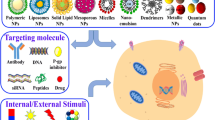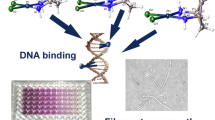Abstract
Purpose
Successful clinical applications of DNA-directed selective cytotoxic agents disrupt the vital replication/transcription processes and ultimately lead to cancer cell death. This study aimed to examine the growth screen of two lead triazine compounds in a number of cell lines and xenografts and to develop anticancer agents with noncovalent binding affinity bringing fewer side effects.
Methods
The NCI initial hollow fiber test was performed using an established procedure. The cytostatic and cytocidal capacities of the test compounds were assessed by evaluating cytotoxicity by simply performing a standard cellular viability assay. The nude mouse human tumor xenograft system was used as an in vivo model.
Results
More sensitive drug with sub-micromolar activity met the interdisciplinary criteria for testing and was referred to evaluations in subcutaneous colorectal carcinoma HCT-116 human tumor xenografted into nude mice. Principal findings of the study: total cytostasis, almost nontoxic schedules, specific working hypotheses, strong rationale for the potential use, and important general implications (relevance to human biology). NSC 710607 displayed in vivo better than Cisplatin and 5-fluorouracil abilities to significantly decrease tumor growth.
Conclusion
Cell proliferation can be reduced or stopped in vivo in view of the xenograft results. The mimic molecule behaves as DNA-binding antitumor antibiotics with great potential as general anticancer agents and deserves further trials. NSC 710607 represents the result of a design strategy with outstanding potential. This study also identifies the prognostic significance and is likely to translate to other species or systems.






Similar content being viewed by others
Data availability
All data used to support the findings of this study are included within the article.
References
Boykin DW, Kumar A, Spychala J, Zhou M, Lombardy RJ, Wilson WD, Dykstra CC, Jones SK, Hall JE, Tidwell RR, Laughton C, Nunn CM, Neidle S (1995) Dicationic diarylfurans as anti-Pneumocystis carinii agents. J Med Chem 38:912–916. https://doi.org/10.1021/jm00006a009
Burden DA, Osheroff N (1998) Mechanism of action of eukaryotic topoisomerase II and drugs targeted to the enzyme. Biochim Biophys Acta 1400:139–154. https://doi.org/10.1016/s0167-4781(98)00132-8
Coleman LW, Rohr LR, Bronstein IB, Holden JA (2002) Human DNA topoisomerase I: an anticancer drug target present in human sarcomas. Hum Pathol 33:599–607. https://doi.org/10.1053/hupa.2002.124911
Dowling CM, Claffey J, Cuffe S, Fichtner I, Pampillon C, Sweeney NJ, Strohfeldt K, Watson RWG, Tacke M (2008) Antitumor activity of titanocene Y in xenografted PC3 tumors in mice. Lett Drug Des Disc 5:141–144. https://doi.org/10.2174/157018008783928463
Gu W, Li Y, Xia Y-Z, Yan T, Yang M-H, Kong L-Y (2022) Structural insight into the bulge-containing KRAS oncogene promoter G-quadruplex bound to berberine and coptisine. Nat Commun. https://doi.org/10.1038/s41467-022-33761-4
Guddneppanavar R, Bierbach U (2007) Adenine-N3 in the DNA minor groove—an emerging target for platinum containing anticancer pharmacophores. Anti-Cancer Agents Med Chem 7:125–138. https://doi.org/10.2174/187152007779313991
Hendry LB, Mahesh VB, Bransome ED Jr, Ewing DE (2007) Small molecule intercalation with double stranded DNA: implications for normal gene regulation and for predicting the biological efficacy and genotoxicity of drugs and other chemicals. Mutat Res 623:53–71. https://doi.org/10.1016/j.mrfmmm.2007.03.009
Jakupec MA, Galanski MS, Arion VB, Hartinger CG, Keppler BK (2008) Antitumour metal compounds: more than theme and variations. Dalton Trans. https://doi.org/10.1039/B712656P
Kraus S, Arber N (2009) Inflammation and colorectal cancer. Curr Opinion Pharmacol 9:405–410. https://doi.org/10.1016/j.coph.2009.06.006
Li H-H, Aubrecht J, Fornace AJ Jr (2007) Toxicogenomics: overview and potential applications for the study of non-covalent DNA interacting chemicals. Mutat Res 623:98–108. https://doi.org/10.1016/j.mrfmmm.2007.03.013
Mastrangelo S, Attina G, Triarico S, Romano A, Maurizi P, Ruggiero A (2022) The DNA-topoisomerase inhibitors in cancer therapy. Biomed Pharmacol J 15:553–562. https://doi.org/10.13005/bpj/2396
McClendon AK, Osheroff N (2007) DNA topoisomerase II, genotoxicity, and cancer. Mutat Res 623:83–97. https://doi.org/10.1016/j.mrfmmm.2007.06.009
McConnaughie AW, Spychala J, Zhao M, Boykin D, Wilson WD (1994) Design and synthesis of RNA-specific groove-binding cations: implications for antiviral drug design. J Med Chem 37:1063–1069. https://doi.org/10.1021/jm00034a004
McIntyre RE, Buczacki SJA, Arends MJ, Adams David J (2015) Mouse models of colorectal cancer as preclinical models. BioEssays 37:909–920. https://doi.org/10.1002/bies.201500032
Nelson SM, Ferguson LR, Denny WA (2007) Non-covalent ligand/DNA interactions: minor groove binding agents. Mutat Res 623:24–40. https://doi.org/10.1016/j.mrfmmm.2007.03.012
Ogbonna EN, Paul A, Ross Terrell J, Fang Z, Chen C, Poon GMK, Boykin DW, Wilson WD (2022) Drug design and DNA structural research inspired by the Neidle laboratory: DNA minor groove binding and transcription factor inhibition by thiophene diamidines. Bioorg Med Chem. https://doi.org/10.1016/j.bmc.2022.116861
Plowman J, Dykes DJ, Hollingshead M, Simpson-Herren L, Alley MC (1997) Preclinical screening, clinical trials, and approval. In: Teicher B (ed) Anticancer drug development guide. Humana Press, Totowa, pp 101–125
Shoemaker RH (2006) The NCI60 human tumour cell line anticancer drug screen. Nat Rev Cancer 6:813–823. https://doi.org/10.1038/nrc1951
Spychala J (1999) A general synthesis of diaryl cyclic diamidines. Tetrahedron Lett 40:2841–2844. https://doi.org/10.1016/S0040-4039(99)00307-X
Spychala J (2006) A convenient way to methylated 2-imidazolines. Syntheses of fluorene and triazine cyclic diamidines. Monatsh Chem 137:1203–1210. https://doi.org/10.1007/s00706-006-0516-y
Spychala J (2008) The usefulness of cyclic diamidines with different core-substituents as antitumor agents. Bioorg Chem 36:183–189. https://doi.org/10.1016/j.bioorg.2008.05.002
Spychala J (2009) Selective cytostatic and cytotoxic anticancer effects of bisfunctional agents: a strategy for the design of DNA binding agents. Cancer Lett 281:203–212. https://doi.org/10.1016/j.canlet.2009.02.026
Spychala J, Boykin DW, Wilson WD, Zhao M, Tidwell RR, Dykstra CC, Hall JE, Jones SK, Schinazi RF (1994) Synthesis of dicationic diaryltriazines nucleic acid binding agents. Eur J Med Chem 29:363–367. https://doi.org/10.1016/0223-5234(94)90061-2
Syriopoulou E, Morris E, Finan PJ, Lambert PC, Rutherford MJ (2019) Understanding the impact of socioeconomic differences in colorectal cancer survival: potential gain in life-years. Br J Cancer 120:1052–1058. https://doi.org/10.1038/s41416-019-0455-0
Todd RC, Lippard SJ (2009) Inhibition of transcription by platinum antitumor compounds. Metallomics 1:280–291. https://doi.org/10.1039/b907567d
Torigoe T, Izumi H, Ishiguchi H, Yoshida Y, Tanabe M, Yoshida T, Igarashi T, Niina I, Wakasugi T, Imaizumi T, Momii Y, Kuwano M, Kohno K (2005) Cisplatin resistance and transcription factors. Curr Med Chem Anti-Cancer Agents 5:15–27. https://doi.org/10.2174/1568011053352587
Torkamani A, Verkhivker G, Schork NJ (2009) Cancer driver mutations in protein kinase genes. Cancer Lett 281:117–127. https://doi.org/10.1016/j.canlet.2008.11.008
Van Cutsem E, Lenz H-J, Kohne C-H, Heinemann V, Tejpar S, Melezinek I, Beier F, Stroh C, Rougier P, van Krieken JH, Ciardiello F (2015) Fluorouracil, leucovorin, and irinotecan plus cetuximab treatment and RAS mutations in colorectal cancer. J Clin Oncol 33:692–700. https://doi.org/10.1200/JCO.2014.59.4812
Wang X (2010) Fresh platinum complexes with promising antitumor activity. Anti-Cancer Agents Med Chem 10:396–411. https://doi.org/10.2174/1871520611009050396
Wemmer DE, Dervan PB (1997) Targeting the minor groove of DNA. Curr Opinion Struct Biol 7:355–361. https://doi.org/10.1016/S0959-440X(97)80051-6
Xie B, Wang Y, Wang D, Xue X, Nie Y (2022) Synthesis, characterization and anticancer efficacy studies of iridium (III) polypyridyl complexes against colon cancer HCT116 cells. Molecules 27:5434. https://doi.org/10.3390/molecules27175434
Zander T, Xue J, Markson G, Dahm F, Renner C (2022) Satraplatin demonstrates high cytotoxic activity against genetically defined lymphoid malignancies. Anticancer Res 42:1821–1832. https://doi.org/10.21873/anticanres.15658
Zhang J, Gong Y, Zheng X, Yang M, Cui J (2008) Synthesis, cytotoxicity and DNA binding levels of tri-functional mononuclear platinum(II) complexes. Eur J Med Chem 43:441–447. https://doi.org/10.1016/j.ejmech.2007.04.015
Zhang B, Lin J, Perculija V, Li Y, Lu Q, Chen J, Ouyang S (2022) Structural insights into target DNA recognition and cleavage by the CRISPR-Cas12c1 system. Nucleic Acids Res. https://doi.org/10.1093/nar/gkac987
Acknowledgements
The author is thankful to Drs. V.L. Narayanan, E. Sausville (NIH, NCI, Bethesda, MD, USA), and Dr. M. Hollingshead (NCI, Frederick, MD, USA) for testing in an in vivo hollow fiber assay. He is forever in debt to Dr. I. Fichtner (Berlin, Germany) for the xenograft data provided within the framework of the EORTC/NCI worldwide activity.
Funding
The sole author has not disclosed any funding.
Author information
Authors and Affiliations
Contributions
Broad conceptualization; methodology; formal analysis and investigation; writing—original draft preparation; writing—review and editing; supervision.
Corresponding author
Ethics declarations
Competing interests
The single author declares no competing interests.
Conflict of interest
The author has no relevant financial or non-financial interests to disclose.
Ethical approval
All animal experiments were done according to the German Animal Protection Law.
Consent to publish
Not applicable.
Additional information
Publisher's Note
Springer Nature remains neutral with regard to jurisdictional claims in published maps and institutional affiliations.
Rights and permissions
Springer Nature or its licensor (e.g. a society or other partner) holds exclusive rights to this article under a publishing agreement with the author(s) or other rightsholder(s); author self-archiving of the accepted manuscript version of this article is solely governed by the terms of such publishing agreement and applicable law.
About this article
Cite this article
Spychala, J. Antitumor activity of triazine mimic antibiotics for DNA-binding implications (impressive activity in vitro against a variety of tumor types in the NCI-60 screen): NSC 710607 to fight HCT-116 human colon carcinoma cell lines in vivo using the hollow fiber assay and xenograft mouse models. J Cancer Res Clin Oncol 149, 6501–6511 (2023). https://doi.org/10.1007/s00432-023-04604-6
Received:
Accepted:
Published:
Issue Date:
DOI: https://doi.org/10.1007/s00432-023-04604-6




